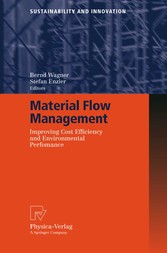Search and Find
Service
More of the content

Material Flow Management - Improving Cost Efficiency and Environmental Performance
6 Environmental Accounting Instruments: Implementation & Continuous Use - Concepts for the Application of Input-Output Balance, Environmental Performance Indicators and Flow Cost Accounting (S.131)
Claus Lang-Koetz, Thomas Loew, Severin Beucker, Michael Steinfeldt, Uwe Horstmann, Till Sieghart
Claus Lang-Koetz, Institute for Human Factors and Technology Management (lAT), University of Stuttgart, Germany
E-mail: claus.lang-koetz@iao.fraunhofer.de
Thomas Loew, Institute for Ecological Economy Research, Berlin/ Germany
E-Mail: thomas.loew@ioew.de
Severin Beucker, Fraunhofer Institute for Industrial Engineering (lAO), Stuttgart/ Germany
E-Mail: severin.beucker@iao.fraunhofer.de
Michael Steinfeldt, Institute for Ecological Economy Research, Berlin/ Germany
Email: michael.steinfeldt@ioew.de
Uwe Horstmann, Conti Temic Microelectronic GmbH, Niimberg/ Germany
Email: uwe.horstmann@temic.com
Till Sieghart, Conti Temic Microelectronic GmbH, Niimberg/ Germany
E-Mail: till.sieghart@temic.com
6.1 Introduction
Within the scope of the three-year research project INTUS, concepts were developed for facilitating the introduction of controlling tools into the internal environmental management systems of enterprises. The new concepts relate to the three key problems with which companies are faced when striving to optimise the internal provision of information in regards to environment-oriented management.
Areas to be considered here include
(i) the suitability of the various environmental accounting tools,
(ii) the provision of the tools by way of information technology, and
(iii) the organisational implementation during the introductory phase and in longterm utilisation.
6.2 Research Project INTUS
One of the classic challenges of controlling is the efficient provision of information at the right time, in an appropriate volume in regards to the task at hand and in a suitable format. Environmental accounting, being a sub-function of environmental management in corporate practice, is faced with this challenge as well.
Today, environmental accounting has access to a wide variety of tools. The most important of these include product life-cycle assessments, corporate input-output balances, environmental performance indicators, various environmental activity-based costing approaches as well as a multitude of ecological assessment methods.
The product life-cycle assessment approaches, which initially showed a quite significant amount of variation, have been unified in the meantime; the methodological fi*amework is described in four ISO standards (ISO 14040 to ISO 14043). In principle, it is known in which cases and with what software support a practical application of product life-cycle assessments and similar approaches is possible.
Up to now, the situation was different concerning tools for supporting production-related environmental management. In this area, corporate input-output balances, environmental performance indicators and flow cost accounting (a highly promising environmental cost management approach) have long since been recommended as particularly promising tools.
.
All prices incl. VAT












